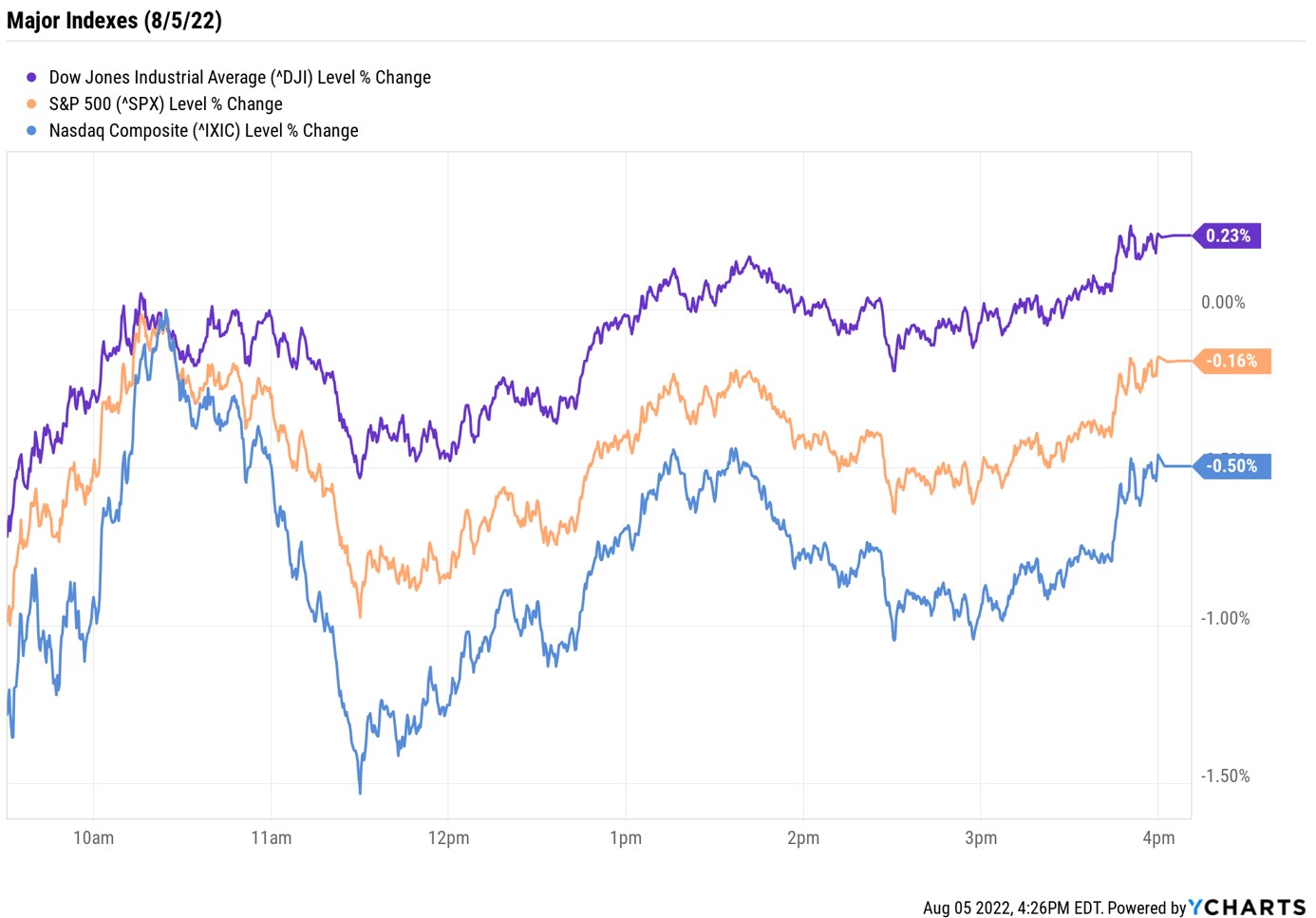Stock Market Today: S&P, Nasdaq Retreat After Sizzling Jobs Report
The U.S. economy has now recouped all of the jobs it lost at the onset of the pandemic, with the unemployment rate falling to its lowest level since early 2020.


A milestone jobs report sent stocks lower on Friday as it sparked concern the Fed will stay aggressive with its rate hikes.
Ahead of the opening bell, the Labor Department said the U.S. economy added 528,000 new jobs in July, more than double what economists were expecting. The U.S. has now recouped all 22 million positions lost in the early months of the pandemic. Also in the report: The unemployment rate fell to 3.5%, a level not seen since February 2020, while average hourly earnings were up 0.5% month-over-month and 5.2% year-over-year.
"Job gains were broad-based and especially prominent in sectors such as education, healthcare and government," says Jeffrey Roach, chief economist for independent broker-dealer LPL Financial. "Given the stability in the job market, especially considering rising borrowing costs and higher inflation, we do not expect the National Bureau of Economic Research (NBER) to call a recession at this point. The labor market is strong enough to offset the weaknesses in other parts of the economy such as real estate."

Sign up for Kiplinger’s Free E-Newsletters
Profit and prosper with the best of expert advice on investing, taxes, retirement, personal finance and more - straight to your e-mail.
Profit and prosper with the best of expert advice - straight to your e-mail.
"This reading is positive for economic growth and households," says Tim Courtney, chief investment officer at investment firm Exencial Wealth Advisors. "It should support consumer spending moving forward. While that is good news, it likely means the Federal Reserve will continue with interest rate hikes."
It's that last point that sent the 10-year Treasury yield spiking 15.4 basis points to 2.83% today. (A basis point is one-one hundredth of a percentage point.) This initially sent stocks deep into the red, though they came off their lows as the session wore on. At the close, the Dow Jones Industrial Average was up 0.2% at 32,803. The S&P 500 Index, meanwhile, was off 0.2% at 4,145, while the tech-heavy Nasdaq Composite – whose components are most sensitive to rising rates – shed 0.5% to 12,657.

Other news in the stock market today:
- The small-cap Russell 2000 gained 0.8% to 1,921.
- U.S. crude futures rose 0.5% to end at $89.01 per barrel.
- A strong dollar sent gold futures down 0.9% to $1,791.20 an ounce.
- Bitcoin rose 2.1% to $22,926.10. (Bitcoin trades 24 hours a day; prices reported here are as of 4 p.m.)
- Lyft (LYFT) spiked 16.6% after the ride-sharing company said it had 19.9 million riders in the second quarter, resulting in revenue per rider of $49.89 (more than the $49.30 analysts were expecting). LYFT also reported an adjusted profit of 13 cents per share compared to expectations for a per-share loss of 4 cents, while revenue jumped 29.5% year-over-year to $990.7 million. "While we are encouraged by the ride-share recovery, partially driven by higher airport volume and momentum in business bookings, we acknowledge concerns about peak travel demand," says CFRA Research analyst Angelo Zino (Buy). "That said, lagging West coast regions (e.g., San Francisco) are now recovering at a faster clip than other regions and should support revenue in the second half. In addition, we like LYFT's increasing emphasis on driving EBITDA growth by being more prudent on expenses."
- Carvana (CVNA) was another big post-earnings winner, with shares surging 40.1%. While the online auto dealer reported lower-than-expected revenue of $3.8 billion and a wider adjusted loss of $2.35 per share in its second quarter, CEO Ernie Garcia said in the company's earnings call that it is "shifting its focus to favor efficiency and cash flow" in response to a challenging economic environment. "As we consider carefully last night's quarterly announcement from CVNA and recent trends at the company, we overall view dynamics as 'better than feared' andsuggestive of underlying stabilizing and improving operational control at the company," says Oppenheimer analyst Brian Nagel (Outperform).
Stay Defensive!
Next up: Inflation data, with the July consumer price index (CPI) set to be released Wednesday morning. Douglas Porter, chief economist at BMO Capital Markets, points to the recent retreat in oil prices – U.S. crude futures fell 6.8% in July, and are down another 9.7% so far in August) as a reason for investors to be encouraged about this upcoming release.
"A moderation in energy and other commodity costs would go a long way to making the Fed's job of controlling inflation expectations much easier," Porter says. "In turn, it could lessen recession risks by removing some of the squeeze on consumers." Still, while the economist says that the headline inflation rate in Wednesday's CPI report could move back below 9% after topping this level in June, it's going to take many months to bring inflation substantially lower.
For investors, this means: Stay defensive. That could include focusing on stocks from the best inflation-proof sectors such as healthcare, consumer staples and utilities. Beverage stocks are also surprisingly good names to buy, not only for inflation protection, but also dividends. And for those that want to spread their risk around, consider these 10 defensive exchange-traded funds (ETFs) that could provide some ballast for choppy waters ahead.
Get Kiplinger Today newsletter — free
Profit and prosper with the best of Kiplinger's advice on investing, taxes, retirement, personal finance and much more. Delivered daily. Enter your email in the box and click Sign Me Up.

With over a decade of experience writing about the stock market, Karee Venema is the senior investing editor at Kiplinger.com. She joined the publication in April 2021 after 10 years of working as an investing writer and columnist at a local investment research firm. In her previous role, Karee focused primarily on options trading, as well as technical, fundamental and sentiment analysis.
-
 Stock Market Today: Trump Retreats, Markets Rejoice
Stock Market Today: Trump Retreats, Markets RejoiceStocks rally, yields soften, the dollar rises, and even beaten-down names enjoy the wages of potential trade peace.
By David Dittman
-
 In Trump’s Economy Should 401(k) Savers 'Set It and Forget It?'
In Trump’s Economy Should 401(k) Savers 'Set It and Forget It?'It’s hard to bury your head in the sand when the markets are volatile. Here’s when it makes sense and when it doesn’t.
By Donna Fuscaldo
-
 Stock Market Today: Trump Retreats, Markets Rejoice
Stock Market Today: Trump Retreats, Markets RejoiceStocks rally, yields soften, the dollar rises, and even beaten-down names enjoy the wages of potential trade peace.
By David Dittman
-
 Stock Market Today: Stocks Soar on China Trade Talk Hopes
Stock Market Today: Stocks Soar on China Trade Talk HopesTreasury Secretary Bessent said current U.S.-China trade relations are unsustainable and signaled hopes for negotiations.
By Karee Venema
-
 Stock Market Today: Dow Drops 971 Points as Powell Pressure Ramps Up
Stock Market Today: Dow Drops 971 Points as Powell Pressure Ramps UpPresident Trump is increasing his attacks against Jerome Powell, insisting the Fed chair cut interest rates.
By Karee Venema
-
 Stock Market Today: No 'Powell Put'? No Problem
Stock Market Today: No 'Powell Put'? No ProblemInvestors, traders and speculators look beyond both another Trump post and more signs of slowing economic activity.
By David Dittman
-
 What Is the Buffett Indicator?
What Is the Buffett Indicator?"It is better to be roughly right than precisely wrong," writes Carveth Read in "Logic: Deductive and Inductive." That's the premise of the Buffett Indicator.
By Charles Lewis Sizemore, CFA
-
 Stock Market Today: Dow Drops 699 Points After Powell Speech
Stock Market Today: Dow Drops 699 Points After Powell SpeechFed Chair Powell warned of a slowing economy and higher inflation but said the central bank isn't ready to cut rates just yet.
By Karee Venema
-
 Stock Market Today: Stocks Struggle Amid Tariff Uncertainty
Stock Market Today: Stocks Struggle Amid Tariff UncertaintyBoeing dropped after China suspended new aircraft orders, while Bank of America and Citi climbed on earnings beats.
By Karee Venema
-
 Stock Market Today: Stocks Gain on Tech, Auto Tariff Talk
Stock Market Today: Stocks Gain on Tech, Auto Tariff TalkThe Trump administration said late Friday that it will temporarily halt tariffs on some Chinese tech imports.
By Karee Venema